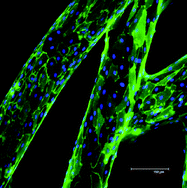Providing adequate vascularization is one of the main hurdles to the widespread clinical application of bone tissue engineering approaches. Due to their unique role in blood vessel formation, endothelial cells (EC) play a key role in the establishment of successful vascularization strategies. However, currently available polymeric materials do not generally support EC growth without coating with adhesive proteins. In this work we present argon plasma treatment as a suitable method to render the surface of a 3D starch-based scaffold compatible for ECs, this way obviating the need for protein pre-coating. To this end we studied the effect of plasma modification on surface properties, protein adsorption and ultimately on several aspects regarding EC behaviour. Characterization of surface properties revealed increased surface roughness and change in topography, while at the chemical level a higher oxygen content was demonstrated. The increased surface roughness of the material, together with the changed surface chemistry modulated protein adsorption as indicated by the different adsorption profile observed for vitronectin. In vitro studies showed that human umbilical vein ECs (HUVECs) seeded on plasma-modified scaffolds adhered, remained viable, proliferated, and maintained the typical cobblestone morphology, as observed for positive controls (scaffold pre-coated with adhesive proteins). Furthermore, genotypic expression of endothelial markers was maintained and neighbouring cells expressed PECAM-1 at the single-cell-level. These results indicate that Ar plasma modification is an effective methodology with potential to be incorporated in biomaterial strategies to promote the formation of vascularized engineered bone.

You have access to this article
 Please wait while we load your content...
Something went wrong. Try again?
Please wait while we load your content...
Something went wrong. Try again?


 Please wait while we load your content...
Please wait while we load your content...